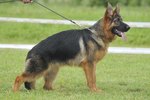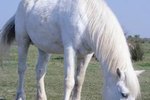Wobblers syndrome or wobbler disease is catchall term that refers to many different spinal-column disorders that are commonly found in large and giant-breed dogs and in certain breeds of horses. The symptoms are leg weakness and clumsy, or "wobbly," walking that may lead to paralysis. Most of the disorders described as wobblers are caused when the cervical (neck) spinal column is compressed and can't send clear signals to the legs. In dogs, it's also called cervical spondylolisthesis, cervical spondylomyelopathy, cervical vertebral instability and cervical vertebral malformation. In horses, it's sometimes called Wobbler's Syndrome. Depending on the cause, untreated animals may grow out of it or otherwise improve, but their symptoms are more likely to stabilize or worsen. According to Bruce R. Wittels, DVM, of the United Kingdom German Shepherd Dog Helpline, cases that are worsening but not treated or are given too-conservative treatment may cause the animal pain, serious movement problems or paralysis. If your pet has wobbler symptoms, take her to the veterinarian. She may have a serious condition that needs treatment right away. If she's more than a year old, take her to the vet immediately---without treatment she may be permanently paralyzed.
Wobblers Syndrome in Dogs
There are two major kinds of wobblers syndrome---slow-onset and acute, or sudden-onset. Slow-onset symptoms usually show up when a dog is between three and 12 months old, according to Wittels. The dog may become very clumsy on slick surfaces, fall when turning and drag his hind feet slightly when he walks. He may have a swaying walk, with wide-swinging back legs. The symptoms usually get worse, but slowly. Acute wobblers usually happens in pets five to seven years old, says Wittels. If your adult dog shows wobblers symptoms and has neck pain, it likely means she has fractured a vertebra or has a protruding disc in her neck. She may need treatment immediately to prevent permanent spinal damage. Slow-onset wobbler symptoms usually happen because the neck vertebrae are malformed, maloccluded (not meeting correctly), or have too narrow of an opening for the spinal column, according to the Textbook of Small Animal Surgery (Douglas Slatter, 2002). Symptoms may also be caused by defective neck cartilage, or because the opening at the base of the dog's skull, where the spine goes in, is too small. Sometimes the dog's vertebrae have grown too fast, or the dog has a big, heavy head and weak neck ligaments. Such problems all put pressure on the spinal cord where it goes through the neck vertebrae, pinching the nerves so that they don't function properly and can't send good signals to the dog's legs.
Untreated Wobblers Disease in Dogs
In acute wobblers disease, untreated dogs are likely to decline rapidly. In most cases, they will experience worsening pain in the neck at the injury site and develop sensitivity or pain in the hind limbs. The "wobbling symptoms" will worsen quickly, and the dog may experience partial or complete paralysis of the hind limbs in as little time as a few hours and up to a few days. It is rare for an untreated dog to improve over time. In slow-onset wobblers disease that is due to fast growth with a high-mineral and/or protein diet, untreated dogs may improve over the course of several months as their cervical vertebrae enlarge. However, dogs with a genetic predisposition to the condition are likely to experience continued or worsening inflammation of the spinal cord, leading to stabilization or worsening of symptoms. If the symptoms worsen, the dogs will lose more limb control and may experience periods of hind-leg paralysis. In the worst cases, this paralysis becomes permanent. They may also develop sensitivity or pain in the hind limbs. If this is the case, the dog may become more unpredictable or aggressive due to sensitivity to otherwise comfortable touch, or due to chronic pain.
Dog Breeds
These breeds are the most likely to develop wobbler disease: Basset Hound Boxer Bull mastiff Dalmatian Dobermann German Shepherd Great Dane Old English Sheepdog Rhodesian Ridgeback Samoyed St. Bernard Weimaraner
Untreated Wobbler Disease in Horses
In horses, the name describes many conditions that cause walking disorders. Common symptoms are weak hindquarters, knuckling over in the fetlocks, and in severe cases, falling. The symptoms may be due to genetic conditions such as equine wobbles anemia, or bone and growth disorders that are similar to those that cause wobblers in dogs. Left untreated, symptoms that are due to growth disorders may improve as the horse grows to adulthood, but they are more likely to stabilize or worsen if the horse does not receive at least conservative treatments, according to Slatter. Symptoms that are due to bone disorders or congenital weakness are likely to worsen over time without treatment. In both cases, the untreated horse will become more clumsy and increasingly weak in the hindquarters. Knuckling over will also increase in some cases. The horse will fall more often and it will become unsafe to ride the horse. The horse may develop pain in the hind feet. The horse may also become more unpredictable or aggressive due to chronic pain. In cases of equine wobbles anemia, there are currently no treatments known. The horse will lose control over its limbs, usually over the course of several months, until it experiences complete limb paralysis.
Horse Breeds
These breeds are the most likely to develop wobbler disease: American Paint Horse American Quarter Horse Standardbred Thoroughbred
References
Photo Credits
-
Copyright (C) 2009 Morgan Stanfield and its licensors. All rights reserved.
Writer Bio
Morgan Stanfield is an internationally published health and science journalist who has served as a writer/editor at the nation's bestselling health magazine and at several international clinical journals, including The Academy Today, Integrative Medicine, and Alternative Therapies in Health and Medicine.




